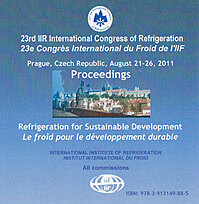
Document IIF
Détection enzymatique de la congélation de viande.
Enzymatic detection of meat freezing.
Numéro : pap. ID: 838
Auteurs : PETROVA M., PIPEK P., ROHLIK B. A., et al.
Résumé
The possible adulteration of fresh meat and its confusion with frozen and thawed meat is a problem. Not only due to the lower price of thawed meat, but also due to its lower sensory quality, which is caused by the damage of the meat structure and chemical changes during freezing and freeze storage. It is therefore necessary to find a way to detect such adulteration. Commercial enzymatic kits were used for the detection of citrate synthase and aconitase activity (mitochondrial enzymes that are released from the organelles, which were destructed by frost). These methods have been previously applied to fish; our determination was to carry out these experiments on meat samples of large slaughter animals (pig and cattle). It was found that applying these methods, it is possible to differentiate fresh and frozen/thawed meat, and to provide convincing results. The absolute results vary with the type of meat and depend on the used enzyme. But the enzyme activity in frozen meat is always higher than in fresh meat exudate. This value further increases with each subsequent freezing cycle. Enzyme activity also increases during partial surface freezing, which is normally used before slicing larger meat parts.
Documents disponibles
Format PDF
Pages : 7 p.
Disponible
Prix public
20 €
Prix membre*
Gratuit
* meilleur tarif applicable selon le type d'adhésion (voir le détail des avantages des adhésions individuelles et collectives)
Détails
- Titre original : Enzymatic detection of meat freezing.
- Identifiant de la fiche : 30001823
- Langues : Anglais
- Source : Proceedings of the 23rd IIR International Congress of Refrigeration: Prague, Czech Republic, August 21-26, 2011. Overarching theme: Refrigeration for Sustainable Development.
- Date d'édition : 21/08/2011
Liens
Voir d'autres communications du même compte rendu (569)
Voir le compte rendu de la conférence
Indexation
-
EFFECT OF FROZEN STORAGE OF BOVINE PSOAS MUSCLE...
- Auteurs : HENAHAN M., MCGRATH A., HARRINGTON M. G.
- Date : 24/08/1981
- Langues : Anglais
Voir la fiche
-
Gel-forming ability is a sensitive indicator of...
- Auteurs : MCDONALD G. A., LANIER T. C.
- Date : 19/09/1999
- Langues : Anglais
- Source : 20th International Congress of Refrigeration: Refrigeration into the Third Millennium.
- Formats : PDF
Voir la fiche
-
THE INFLUENCE OF ELECTRICAL STIMULATION AND ALT...
- Auteurs : GOLOVKIN N. A., EVELEY S. A., VOROBYOVA N. N.
- Date : 1986
- Langues : Anglais
Voir la fiche
-
EFFECT OF BACTERIOPHAGES ON THE COLOUR AND DISP...
- Auteurs : GREER G. G.
- Date : 10/09/1986
- Langues : Anglais
- Formats : PDF
Voir la fiche
-
Quality differences in fast freezing.
- Auteurs : LONDAHL G., GORANSSON S., SUNDSTEN S., ANDERSSON A., TORNBERG E.
- Date : 20/08/1995
- Langues : Anglais
- Source : For a Better Quality of Life. 19th International Congress of Refrigeration.
- Formats : PDF
Voir la fiche
